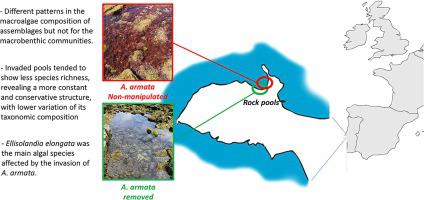Ecological Indicators ( IF 7.0 ) Pub Date : 2021-02-23 , DOI: 10.1016/j.ecolind.2021.107463 Carla O. Silva , Marco F.L. Lemos , Rui Gaspar , Carlos Gonçalves , João M. Neto

|
Biological invasions represent a threat to ecosystems, through competition and habitat destruction, which may result in significant changes of the invaded community. Asparagopsis armata Harvey 1855 is a red macroalgae (Rodophyta) globally recognized as an invasive species. It is found from the intertidal to shallow subtidal areas, on rock or epiphytic, forming natural vegetation belts on exposed coasts. This study evaluated the variations on native intertidal seaweed and macroinvertebrate assemblages inhabiting rock pools with and without the presence of the invasive macroalgae A. armata. To achieve this, manipulation experiments on Atlantic (Portugal) rock pools were done. Three rock pools were maintained without A. armata by manual removal of macroalgae, and three others were not experimentally manipulated during the study period and A. armata was freely present. In this study the variations between different rock pools were assessed. Results showed different patterns in the macroalgae composition of assemblages but not for the macrobenthic communities. Ellisolandia elongata (J. Ellis & Solander) K.R. Hind & G.W. Saunders 2013 was the main algal species affected by the invasion of A. armata. Invaded pools tended to show less macroalgal species richness, showing a more constant and conservative structure, with lower variation of its taxonomic composition than the pools not containing A. armata, where the variability between samples was always higher. Despite the importance of the achieved results, further data based on observation of long-term series are needed, in order to further understand more severe effects of the invader A. armata on native macroalgal assemblage.
中文翻译:

入侵性海藻天冬粉对原生岩池群落的影响:来自实验排除的证据
生物竞争通过竞争和栖息地破坏对生态系统构成威胁,这可能导致被入侵社区的重大变化。Asparagopsis ARMATA哈维1855是红色海藻(Rodophyta)全球公认的入侵物种。从潮间带到浅潮下带,在岩石或附生上发现,在裸露的海岸上形成天然植被带。这项研究评估了居住在岩石池中的天然潮间带海藻和大型无脊椎动物组合的变化,不论是否存在入侵的大藻A. armata。为了达到这个目的,在大西洋(葡萄牙)的岩石池上进行了操纵实验。维护了三个没有A.armata的岩石池通过手动去除大型藻类,在研究期间未对其他三个藻类进行实验性操作,并且自由存在A. armata。在这项研究中,评估了不同岩石池之间的差异。结果表明,大型藻类组合的模式不同,但大型底栖动物群落却没有。Ellisolandia elongata(J. Ellis&Solander)KR Hind&GW Saunders 2013是受到A. armata入侵影响的主要藻类。入侵的池往往显示出较少的大型藻类丰富度,显示出更恒定和保守的结构,其分类学组成的变化比不含A. armata的池低,样本之间的差异始终较高。尽管取得的结果很重要,但仍需要基于长期序列观察的进一步数据,以便进一步了解入侵者曲霉对本地大型藻类组合的更严重影响。











































 京公网安备 11010802027423号
京公网安备 11010802027423号